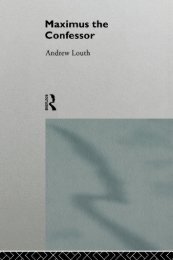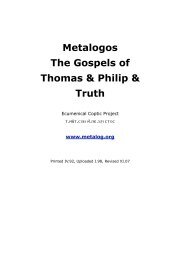Gospels of Thomas and Philip and Truth - Syriac Christian Church
Gospels of Thomas and Philip and Truth - Syriac Christian Church
Gospels of Thomas and Philip and Truth - Syriac Christian Church
Create successful ePaper yourself
Turn your PDF publications into a flip-book with our unique Google optimized e-Paper software.
(1) Are the Coptic <strong>Gospels</strong> Gnostic?<br />
‘The leaning <strong>of</strong> sophists towards the bypaths <strong>of</strong> apocrypha is a constant quantity.’<br />
— James Joyce, Ulysses<br />
Ever since the initial announcement <strong>of</strong> the Nag Hammadi find, <strong>and</strong> unto the<br />
present day, the library as a whole has been consistently called ‘gnostic’, both in the<br />
scholarly literature <strong>and</strong> in the popular press. 1 To begin with, the entire Nag Hammadi<br />
Library was so labelled in the Preface to the first bilingual editions <strong>of</strong> <strong>Thomas</strong> (1959;<br />
Biblio.6)— which classification was subsequently accepted by virtually everyone<br />
who looked into the text. Thus, representative <strong>of</strong> almost all subsequent publications<br />
was the report <strong>of</strong> Robert M. Grant & David Noel Freedman, The Secret Sayings <strong>of</strong><br />
Jesus (1960): ‘[Regarding] the Gospel <strong>of</strong> <strong>Thomas</strong>, [Jean] Doresse looked through<br />
this gospel in the spring <strong>of</strong> 1949 <strong>and</strong> later announced that it was “a Gnostic<br />
composition”.... The Gospel <strong>of</strong> <strong>Philip</strong> contains nothing but Gnostic speculations.’<br />
Wiser counsel, at least regarding <strong>Thomas</strong>, soon came from no less an authority than<br />
Gilles Quispel at the centenary meeting <strong>of</strong> the Society <strong>of</strong> Biblical Literature in 1964:<br />
‘The Gospel <strong>of</strong> <strong>Thomas</strong> ... is not gnostic at all. The adherents <strong>of</strong> the gnostic<br />
interpretation ... must explain how the author could possibly say that the buried<br />
corpse could rise again (logion 5, Greek version).’ Unfortunately, however, Quispel's<br />
seemingly irrefutable point was soon eclipsed by a surge <strong>of</strong> fascination, in both<br />
academic publications <strong>and</strong> the media, with gnosticism's apparently more exotic<br />
enticements.<br />
While there may well be gnostic writings amongst the several dozen titles found<br />
so significantly near the site <strong>of</strong> Saint Pachomius' archetypal monastery, the three<br />
Coptic <strong>Gospels</strong> in that collection are demonstrably not gnostic in content. This can<br />
most readily be shown via an ordinary syllogism; the remainder <strong>of</strong> the present essay<br />
1 The citations in Recent Scholarly Comments, in the Introduction above, are but notable exceptions— which the student will<br />
encounter only by an extensive review <strong>of</strong> the more academic literature. More typical are the prejudicial titles <strong>of</strong> Elaine Pagel’s<br />
best-selling The Gnostic <strong>Gospels</strong> (1979); E.J. Brill’s entire scholarly series, Nag Hammadi Studies: The Coptic Gnostic<br />
Library; <strong>and</strong> The Coptic Gnostic Library: A Complete Edition <strong>of</strong> the Nag Hammadi Codices, General Editor James M. Robinson<br />
(2006 edition)— for these last two, more appropriate titles would surely be The Coptic Monastic Library etc.<br />
111




